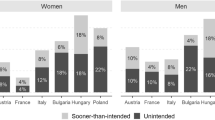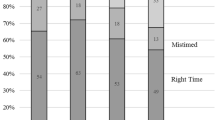Abstract
A thorough understanding of the health implications of unwanted and unintended pregnancies is constrained by our ability to accurately identify them. Commonly used techniques for measuring such pregnancies are subject to two main sources of error: the ex post revision of preferences after a pregnancy and the difficulty of identifying preferences at the time of conception. This study examines the implications of retrospective and prospective measurement approaches, which are vulnerable to different sources of error, on estimates of unwanted and unintended pregnancies. We use eight waves of closely-spaced panel data from young women in southern Malawi to generate estimates of unwanted and unintended pregnancies based on fertility preferences measured at various points in time. We then compare estimates using traditional retrospective and prospective approaches to estimates obtained when fertility preferences are measured prospectively within months of conception. The 1,062 young Malawian women in the sample frequently changed their fertility preferences. The retrospective measures slightly underestimated unwanted and unintended pregnancies compared to the time-varying prospective approach; in contrast the fixed prospective measures overestimated them. Nonetheless, most estimates were similar in aggregate, suggesting that frequent changes in fertility preferences need not lead to dramatically different estimates of unwanted and unintended pregnancy. Greater disagreement among measures emerged when classifying individual pregnancies. Carefully designed retrospective measures are not necessarily more problematic for measuring unintended and unwanted fertility than are more expensive fixed prospective ones.

Similar content being viewed by others
Notes
See Gipson et al. [9] for a detailed review of this literature and its limitations.
Although it could be used to measure unwanted pregnancy using a pregnancy history, we are not aware of any studies (beside the present one) that have used a pregnancy history in this way.
Tsogolo la Thanzi is a research project designed by Jenny Trinitapoli and Sara Yeatman and funded by grant (R01-HD058366) from the National Institute of Child Health and Human Development.
The question in Chichewa, nanga mimbayi mumayifuna, translates to “did you want this pregnancy?” Although not explicitly describing timing, responses to the question suggest that respondents interpreted it that way. Nonetheless, the wording remains a limitation of the measure.
Thirty-six of the 48 missing cases were due to women missing pregnancy questionnaires. The additional 12 were due to “don't know” or “no preference/whenever” responses to questions on the desired timing of next child. We conducted a sensitivity analysis in which we classified “don’t know” responses as a desire to delay and “no preference/whenever” responses as a desire to have a child soon (<2 years). Neither our estimates nor the differences between estimates changed significantly.
If we assume conceptions occur midway between survey waves on average, the gap would be 2 months.
References
Santelli, J., Rochat, R., Hatfield-Timajchy, K., Gilbert, B. C., Curtis, K., Cabral, R., et al. (2003). The measurement and meaning of unintended pregnancy. Perspectives on Sexual and Reproductive Health, 35, 94–101.
Westoff, C. F., & Ryder, N. B. (1977). The predictive validity of reproductive intentions. Demography, 14, 431–453.
Bongaarts, J. (1992). Do reproductive intentions matter? International Family Planning Perspectives, 18, 102–108.
Casterline, J. B., & el-Zeini, L. O. (2007). The estimation of unwanted fertility. Demography, 44, 729–745.
Gillespie, D., Ahmed, S., Tsui, A., & Radloff, S. (2007). Unwanted fertility among the poor: An inequity? Bulletin of the World Health Organization, 85, 100–107.
Campbell, A. A., & Mosher, W. D. (2000). A history of the measurement of unintended pregnancies and births. Maternal and Child Health Journal, 4, 163–169.
Klerman, L. V. (2000). The intendedness of pregnancy: A concept in transition. Maternal and Child Health Journal, 4, 155–162.
Brown, S. S., & Eisenberg, L. (Eds.). (1995). The best intentions: Unintended pregnancy and the well-being of children and families. Washington, DC: National Academy Press.
Gipson, J. D., Koenig, M. A., & Hindin, M. J. (2008). The effects of unintended pregnancy on infant, child, and parental health: A review of the literature. Studies in Family Planning, 39, 18–38.
Singh, A., Singh, A., & Mahapatra, B. (2013). The consequences of unintended pregnancy for maternal and child health in rural India: Evidence from prospective data. Maternal and Child Health Journal, 17, 493–500.
Singh, S., Sedgh, G., & Hussaid, R. (2010). Unintended pregnancy: Worldwide levels, trends, and outcomes. Studies in Family Planning, 41, 241–250.
Trussell, J., Vaughan, B., & Stanford, J. (1999). Are all contraceptive failures unintended pregnancies? Evidence from the 1995 National Survey of Famliy Growth. Family Planning Perspectives, 31(246–247), 260.
Bankole, A., & Westoff, C. F. (1998). The consistency and validity of reproductive attitudes: Evidence from Morocco. Journal of Biosocial Science, 30, 439–455.
Bongaarts, J. (1990). The measurement of wanted fertility. Population and Development Review, 16, 487–506.
Koenig, M. A., Acharya, R., Singh, S., & Roy, T. K. (2006). Do current measurement approaches underestimate levels of unwanted childbearing? Evidence from rural India. Population Studies, 60, 243–256.
Williams, L., & Abma, J. (2000). Birth wantedness reports: A look rorward and a look back. Biodemography and Social Biology, 47, 147–163.
Abma, J. C., Chandra, A., Mosher, W. D., Peterson, L. S., & Piccinino, L. J. (1997). Fertility, family planning, and women’s health: New data from the 1995 National Survey of Family Growth: Vital and health statistics. Series 23, data from the National Survey of Family Growth.
Finer, L. B., & Zolna, M. R. (2011). Unintended pregnancy in the United States: Incidence and disparities, 2006. Contraception, 84, 478–485.
Bradley, S. E. K., Croft, T. N., Fishel, J. D., & Westoff, C. F. (2012). Revising unmet need for family planning. DHS analytical studies No. 25. Calverton. MD: ICF International.
Rutstein, S. O., & Rojas, G. (2006). Guide to DHS statistics: Demographic and health surveys. Calverton: ORC Macro.
Yeatman, S., Sennott, C., & Culpepper, S. (2013). Young women’s dynamic family size preferences in the context of transitioning fertility. Demography, 50, 1715–1737.
Heiland, F., Prskawetz, A., & Sanderson, W. C. (2008). Are individuals’ desired family sizes stable? Evidence from West German panel data. European Journal of Population, 24, 129–156.
Iacovou, M., & Tavares, L. P. (2011). Yearning, learning, and conceding: Reasons men and women change their childbearing intentions. Population and Development Review, 37, 89–123.
Liefbroer, A. C. (2009). Changes in family size intentions across young adulthood: A life-course perspective. European Journal of Population, 25, 363–386.
Kodzi, I. A., Casterline, J. B., & Aglobitse, P. (2010). The time dynamics of individual fertility preferences among rural Ghanaian women. Studies in Family Planning, 41, 45–54.
Sennott, C., & Yeatman, S. (2012). Stability and change in fertility preferences among young women in Malawi. International Perspectives on Sexual and Reproductive Health, 38, 34–42.
Gipson, J. D., Hossain, M. B., & Koenig, M. A. (2011). Measurement of and trends in unintended birth in Bangladesh, 1983–2000. Journal of Health, Population and Nutrition, 29, 400–405.
MDHS: Malawi Demographic and Health Survey 2010. (2011). Zomba, Malawi and Calverton, Maryland. USA: National Statistical Office (NSO) and ICF Macro.
Poole, V. L., Flowers, J. S., Goldenberg, R. L., Cliver, S. P., & McNeal, S. (2000). Changes in intendedness during pregnancy in a high-risk multiparous population. Maternal and Child Health Journal, 4, 179–182.
Kaufmann, R. B., Morris, L., & Spitz, A. M. (1997). Comparison of two question sequences for assessing pregnancy intentions. American Journal of Epidemiology, 145, 810–816.
Joyce, T., Kaestner, R., & Korenman, S. (2000). The stability of pregnancy intentions and pregnancy-related maternal behaviors. Maternal and Child Health Journal, 4, 171–178.
Guzzo, K. B., Hayford, S. R. (2013). Revisiting retrospective reporting of birth intendedness. Bowling Green State University, Center for Family and Demographic Research, Working Paper Series.
Acknowledgments
An earlier version of this article was presented at the 2013 IUSSP International Population Conference in Busan, Republic of Korea. The data used in this study and the time afforded to the authors for this research were supported by grants from the National Institute of Child Health and Human Development (R01-HD058366; R01-HD077873). For valuable feedback on earlier drafts, we are grateful to Ilene Speizer, John Casterline and the journal’s reviewers; any errors are our own. The research was made possible by the Tsogolo la Thanzi team, particularly Abdallah Chilungo, Sydney Lungu, Hazel Namadingo, and Jenny Trinitapoli.
Author information
Authors and Affiliations
Corresponding author
Rights and permissions
About this article
Cite this article
Yeatman, S., Sennott, C. The Sensitivity of Measures of Unwanted and Unintended Pregnancy Using Retrospective and Prospective Reporting: Evidence from Malawi. Matern Child Health J 19, 1593–1600 (2015). https://doi.org/10.1007/s10995-015-1669-2
Published:
Issue Date:
DOI: https://doi.org/10.1007/s10995-015-1669-2




